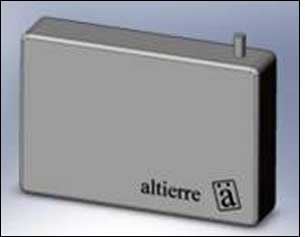Altierre, a San Jose, Calif., provider of wireless solutions for retailers, has released a new temperature-sensing product designed to help stores monitor the conditions under which food is stored or displayed. The system can be installed in a matter of hours, with a typical cost to a supermarket of approximately $15,000, including software, sensor tags and interrogators. Alternatively, it can be added to an Altierre wireless shelf tag system already installed, by simply deploying the sensor tags, priced at less than $10 apiece.
Several food chains in the U.S. Midwest and Northwest regions are beginning to pilot the system, or soon plan to do so, according to Sunit Saxena, Altierre’s chairman and CEO, though he declines to name these companies. Some of those piloting the system are already customers of the firm’s electronic shelf label (ESL) system (see Two Food Chains Trial RFID-based Electronic Shelf Labels). Others intend to try the system as a stand-alone solution by installing sensor tags in cooling units, as well as installing the interrogators and software to read them and interpret their data.
Food retailers often monitor their cooling and heating units by sending an employee with a clipboard to manually record temperatures by hand on a scheduled basis, sometimes four or five times daily. If a problem occurs in between those inspections—such as a door being left open, or an equipment breakdown—it can be hours before the staff knows about it.
Altierre’s new temperature-monitoring system, Saxena says, provides a return on investment (ROI) simply by reducing the labor hours spent manually reading the units’ thermometers. However, he says, it will also reduce the wastage that occurs when products must be discarded if a store discovers a freezer, refrigerator or hot food display case not operating properly. In such situations, workers tend to notice a problem with a unit long after a malfunction first occurs, forcing the retailer to discard all food within that unit since it is impossible to know how long it remained at the incorrect temperature. The cost of such wastage, Saxena notes, is difficult to measure.
“Part of our effort, from day one, has been to create a full platform giving users multiple applications,” Saxena states. That platform began with the wireless ESL tags, and now includes the temperature-monitoring tags. The company plans to add additional features in the future, he says, without revealing what they might be. “Once you’ve put in a wireless infrastructure,” he says, “it opens options for other features that will increase the ROI.”Typically, a 60,000-square-foot location would require two Altierre interrogators to exchange data with the store’s Altierre 2.4 GHz active RFID tags, via a proprietary air-interface protocol. The sensor tag, which measures 2.5 inches by 1.5 inches and is half an inch thick, can be placed directly inside a refrigerator or freezer. With a heating unit, such as one used to display roasted chickens, a temperature probe is placed within its heated interior and plugged into an RFID tag sitting outside of the unit. The tag continually measures the temperature, and interrogators capture its unique ID number, along with sensor data.
When installing a sensor tag, the retailer’s staff uses a handheld interrogator to read its unique ID number. To link the tag with a specific heating or cooling unit being monitored, workers can utilize a bar-code scanner to scan a bar-coded identification label on that unit, or they can key in its ID number. The software can then be defined to send alerts based on predetermined data. If a unit’s internal temperature changes by two degrees, for instance, a message could be transmitted to a store’s manager and maintenance crew. If the temperature continues to change, a second alert could then be sent to the same individuals, as well as to a remote location (such as the company’s headquarters) or to other employees on-site, thus indicating the problem has not yet been resolved.
According to Saxena, there are no other temperature-tracking solutions like this one (using active RFID tags in retail locations) currently available, though wireless temperature tracking is commonly managed in hospitals by such technologies as Wi-Fi- or ZigBee-based RFID tags (see RFID Helps St. Joseph’s Keep an Eye on Cold Storage and Jackson Memorial Enlists Thousands of RFID Tags to Track Assets). However, he notes, Wi-Fi has limits in terms of the number of sensors that could be used, while a typical store might require hundreds or thousands of sensors.
“Going to thousands of devices would be difficult on Wi-Fi,” Saxena explains. “Additionally, since we have a much lower power architecture, this could read and record at much more frequent intervals, while consuming much less power.” Under normal operating conditions, he indicates, the tag’s coin battery is expected to last five years.
Altierre’s new product announcement comes a week after the United States’ House Energy and Commerce Committee sent an amended version of the Food Safety Enhancement Act of 2009 (HR 2749) bill for a vote by the full House of Representatives. The bill would amend the Federal Food, Drug, and Cosmetic Act to improve the safety of food in the global market, and direct the U.S. Food and Drug Administration (FDA) to take steps to reduce food-borne illnesses. If passed by the House, the bill would continue on to the Senate.



